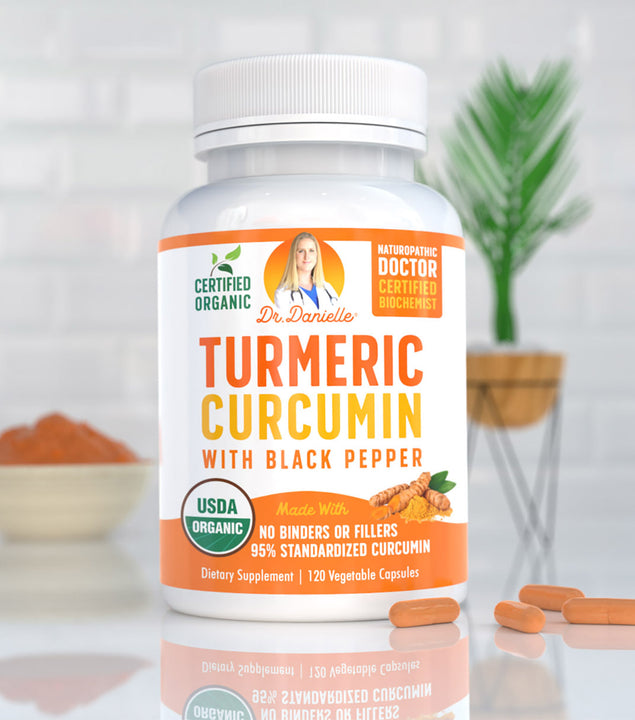Calcium. Lots and lots of it. Chances are, that would have been the first thing to pop up in your mind after reading the title. That's not wrong; far from it. The only issue is that calcium is so widely – and frequently – touted as an “ingredient” for strong, healthy bones that it’s all getting a little, well, stale. So what else could you do, in addition to loading up on calcium-rich foods, like dairy products, canned salmon, and dark green, leafy vegetables?
Luckily, as it turns out, many. There are even a few that may make your jaw drop and have you questioning: “That helps my bones … how?” But we're getting ahead of ourselves; let's start from the beginning.
Why does bone health matter?

In addition to providing structure (you’d look more like a blobfish without them), they’re also crucial for protecting organs (including your brain, heart, and lungs) and anchoring muscles (in turn, enabling movement of your body) (1). Okay, but what’s all the fuss about if you currently have no issues with bone health? Regrettably, this (i.e., healthy, strong bones) may not last.
See: bone is a living tissue that constantly renews itself (2). Right now, your body is making new bone – while breaking down old bone. When you’re young, your body makes new bone faster than it breaks down old bone. That means your “net bone density” is positive; you’re gaining bone mass. Unfortunately, as hinted at earlier, this doesn’t last. In general, most people reach their peak bone mass around age 30 (3). Although bone remodeling continues past this point, you’d start losing slightly more bone mass than you gain.
Fail to counteract this loss, and your risk for developing osteoporosis, a condition that causes bones to become weak and brittle – significantly increases. So, how, exactly, can you counteract this worrying trend of bone mass loss? There are six things you could do.
#1: Get more antioxidants
Why antioxidants? For that, we’ll have to look at what goes on during the bone remodeling process. Very briefly, here’s what you need to know. Continuous bone regeneration is made possible by the coordinated action of three major types of bone cells: osteoclasts, osteoblasts, and osteocytes (4, 5). Osteoclasts eliminate old or damaged bone tissue; osteoblasts form new bone tissue, while the osteocytes send signals of bone formation (or bone resorption) in response to mechanical strain. In other words, when these three types of bone cells work well together, your body makes strong, healthy bones.
But there’s a catch. Research shows that oxidative damage – something that naturally accumulates with age – alters bone remodeling (6, 7, 8). More specifically, it causes an unbalance between osteoclast and osteoblast activity, contributing to an increased bone mass loss. And that’s where antioxidants come in. Their ability to neutralize free radicals means that antioxidants could help prevent, or at least mitigate, oxidative stress in the body (9). This, in turn, enables you to hold on to more bone mass. Given this, is it any surprise to learn that studies have shown vitamin C (which, by the way, is found in Dr. Danielle’s Elderberry Immune Assist) capable of protecting bone cells from damage (10)? Of course, don't feel limited to vitamin C, either. There are plenty of potent antioxidants out there, including Turmeric (e.g., Dr. Danielle’s Turmeric Curcumin) and alpha-lipoic acid (e.g., Dr. Danielle’s Alpha Lipoic Acid) – to name a few.
#2: Consume enough protein
You know that protein is the main component of your muscles – but are you aware the same applies to your bones, too? What most people would find surprising to learn is that bone is, in fact, 35% protein and requires a steady supply of amino acids for its regeneration (11). Thus, highlighting the importance of consuming enough protein in your diet. In support of this, numerous studies have found that individuals (older women, in particular) who consume higher amounts of protein tend to have a higher bone density (12, 13, 14).
Take this 2014 observational study published in The American Journal of Clinical Nutrition, for instance (15). Amongst 144,000 postmenopausal women, researchers found a link between higher protein intake and a lower risk of forearm fractures, plus significantly higher bone density in the hip, spine, and total body. As to what constitutes “enough protein”, well, current recommendations hover around 1.2 and 1.5 g/kg per day (16). Assuming you weigh 60 kg, that means you should aim for a daily protein intake between 72 g to 90 g.
#3: Load up on micronutrients
There are four micronutrients essential for bone health. First up, vitamin D. This vitamin helps your body absorb calcium. And this, in turn, explains why studies consistently find that children and adults with low vitamin D levels tend to have lower bone density and are more at risk for bone loss than those who get enough (17, 18).
While you can hit your recommended daily vitamin D intake (600 IU) through sun exposure and food sources (e.g., fatty fish, liver, and cheese), it can still be a challenge for many people (19). The second micronutrient you should watch out for? Vitamin B12. Research shows that a deficiency in vitamin B12 could interfere with the action of osteoblasts, bone cells responsible for forming new bone tissue (20). This is supported by numerous studies linking vitamin B12 deficiency with low mineral density in men and women alike (21).
As with vitamin D, you could hit your recommended daily intake – 2.4 mcg – for vitamin B12 through your diet (22). But in today’s world, having 24/7 access to healthy, nutritious meals could undeniably be a challenge; so, those struggling to get enough vitamin D and B12 in their daily lives should consider a supplement, like Dr. Danielle’s Vitamin D3 + B12 Gummies.
Now, back to the last two micronutrients you should be mindful of: vitamin K2 and phosphorus. Vitamin K2 plays a crucial role in calcium metabolism. It activates the calcium-binding actions of two proteins: matrix GLA protein and osteocalcin, in turn, helping build and maintain bones (23, 24). As evidence for vitamin K2’s beneficial impact on bone health, a 2013 study published in Osteoporosis International found that postmenopausal women who’ve taken vitamin K2 supplements experienced much slower decreases in age-related bone mineral density than those who did not, over three years (25).
Lastly, phosphorus. Contrary to the previous three micronutrients, this is one mineral you don’t want to be too enthusiastic with, at least in the wrong form (i.e., exceeding the recommended dietary allowance of 700 mg). That’s because high dietary phosphorus has been shown to cause bone loss. Worse still, every 100 mg of phosphorus intake appears to increase the risk of fractures by 9% (26)! In general, the average individual faces little risk in eating too much phosphorus – with one important exception.
That is, if they’re huge fans of soda drinks (27). That’s because soft drinks contain phosphoric acid, which is, yep, you guessed it: made from the mineral phosphorus. Given that one soda may have up to 500 mg of phosphoric acid, well, you do have to moderate your consumption.
#4: Perform weight-bearing exercises
Physical inactivity is a well-documented cause of bone loss; in other words, exercise is vital for building – and maintaining – strong bones throughout all ages. Remember your osteocytes? These are the bone cells that respond to “mechanical strain”. You may not have understood what that meant at first read, but everything should become clear with this explanation: exercise works on bones much like it works on muscles. The more you demand of them, the stronger they become.
So, when you exercise regularly, your bone (i.e., osteocytes) adapts by building more bone and becoming denser. Of all the physical activities you could do, weight-bearing exercise is one of the best for bone health (28, 29, 30, 31). Note that you don’t necessarily need to strength train in the gym; yoga, Pilates, barres, and even stair-climbing are considered weight-bearing exercises! Just remember to replenish all the electrolytes you’ve lost during exercise (e.g., with Dr. Danielle’s Electrolytes)!
#5: Take care of your gut health
Studies suggest that your gut microbiota – the diverse community of bacteria and other microbes living in your gastrointestinal tract – may affect bone density and the absorption of calcium and other minerals needed for healthy bones (32). Given this, taking probiotics (like Dr. Danielle’s Probiotics) almost seems like the logical next step for anyone looking to build stronger, healthier bones. But is there any scientific support for this? Yes, plenty.
According to this 2018 study published in the Journal of Internal Medicine, researchers found that daily oral doses of Lactobacillus reuteri 6475 resulted in significantly reduced loss of total bone mineral density in older women after 12 months (33). Another 2015 clinical trial published in PLoS One involving patients with osteoporosis showed that drinking kefir (i.e., fermented milk) for six months increased bone mineral density in men (34).
Oh, and here’s a bonus tip: beyond simply increasing the number of “good” bacteria in your gut, you may also wish to show extra care to your gut lining by supplementing with Dr. Danielle’s Gut Assist. After all, an unhealthy gut lining may have large cracks or holes – allowing partially digested food and toxins to penetrate the tissues beneath it (35). This would, imaginably, undermine your past efforts at boosting bone health.
Consult a doctor on bone diseases
As highlighted in this article, you could make many lifestyle tweaks to encourage stronger, healthier bones. But an important thing to keep in mind is that they don't treat specific bone conditions. So if you're concerned about your bone health or suspect that you're at risk of osteoporosis, consult your doctor. They could then recommend a bone density test, which will help them determine your rate of bone loss – and whether that warrants osteoporosis medications, for example.









1 comment
Thank you